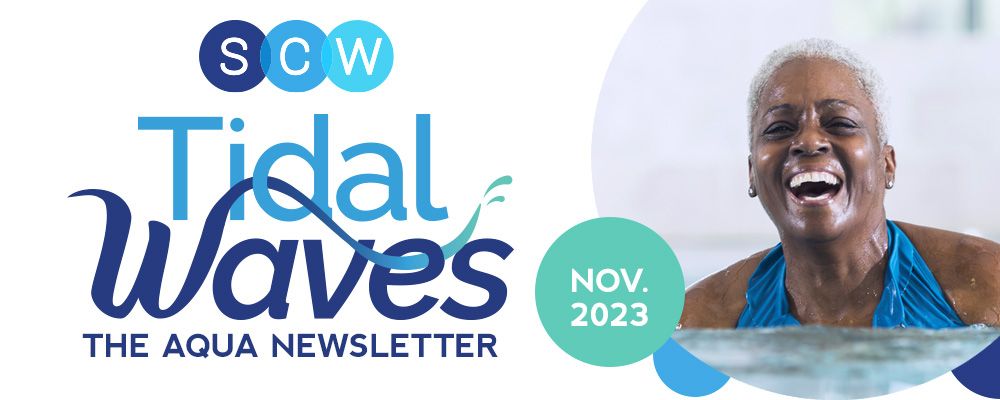
Aquatic Dance for Fitness
by Laura Mikszan
Dance fitness in the water can be a great way to combat the intimidation often associated with dance and exercise for several reasons:
- Lower impact: Water-based dance fitness is gentler on the joints due to the buoyancy of water. This makes it a more accessible option for individuals who may be concerned about the potential impact and strain on their joints during dance and exercise.
- Reduced risk of injury: Water’s supportive environment decreases the risk of injuries. This can be particularly reassuring for individuals who are new to dance or exercise and worry about accidents or strains.
- Inclusive and adaptable: Water-based dance fitness classes are often designed to be inclusive, accommodating people of various fitness levels, ages, and abilities. Instructors typically offer modifications to cater to different needs, making it less intimidating for newcomers.

- Privacy and comfort: Being in the water can provide a sense of privacy and comfort. Some individuals may feel self-conscious about dancing or exercising in a traditional studio or gym setting, but the water can offer a more intimate and less judgmental atmosphere.
- Supportive group environment: Many water fitness classes are conducted in a group setting, where participants support and encourage each other. This group dynamic can boost confidence and reduce the fear of judgment.
- Positive atmosphere: Water fitness instructors often create a positive and encouraging atmosphere, helping participants feel more comfortable and less intimidated. The focus is typically on having fun and enjoying the experience.
- Focus on fun and rhythm: In water-based dance fitness, the emphasis is often on having fun and moving to the rhythm of the music. This can make the experience feel less like a strict workout and more like an enjoyable activity.
- Cognitive benefits: Learning new dance movements can challenge your mind and memory, which can be empowering and fulfilling. It shifts the focus from feeling intimidated to the joy of mastering new patterns.
- Progress at your own pace: In a water-based fitness class, you can progress at your own pace. There’s no pressure to keep up with others, and you can gradually build confidence and skills over time.
- Stress reduction: The soothing nature of water can help reduce stress and anxiety, which can make the experience of dance fitness more enjoyable and less intimidating.
- Health benefits: Focusing on the health benefits of dance fitness in the water, such as improved cardiovascular health and muscle tone, can motivate individuals to overcome their intimidation and give it a try.
 LaBlast® Splash, is an aquatic dance fitness program based on many of the ballroom dances seen on “Dancing with the Stars.” No partner is needed in this supportive and encouraging environment designed for those with no dance experience. Louis Van Amstel, 3x World Champion and Dancing with the Stars Pro added LaBlast® Splash as a complement to the LaBlast® Fitness program, as he realized that the water is a great equalizer for all fitness levels. This format encompasses interchangeable patterns accessible to all fitness levels, set to music from all genres and eras.
LaBlast® Splash, is an aquatic dance fitness program based on many of the ballroom dances seen on “Dancing with the Stars.” No partner is needed in this supportive and encouraging environment designed for those with no dance experience. Louis Van Amstel, 3x World Champion and Dancing with the Stars Pro added LaBlast® Splash as a complement to the LaBlast® Fitness program, as he realized that the water is a great equalizer for all fitness levels. This format encompasses interchangeable patterns accessible to all fitness levels, set to music from all genres and eras.
The patterns used in LaBlast® Splash teach the true form of dance while infused with traditional aquatic moves. For example, the pendulum swing is a basic pattern of the ballroom dance “the quickstep”, as well as a customary ‘rocking horse’ fits the samba rhythm perfectly. Often members will attempt skills in the water they wouldn’t necessarily try on land, such as a full turn in the Viennese waltz, because there is less fear of falling.
LaBlast® Splash, and other dance fitness programs in the water, focus on enjoyment and fun all of which can help combat the intimidation that people may associate with traditional dance and exercise. It provides a gateway for individuals to engage in physical activity and experience many benefits of fitness without feeling overwhelmed or fearful.
To experience LaBlast® Splash in person, join the LaBlast® Team at DC MANIA®, February 23-25 at the Hyatt Regency Dulles Hotel. For more information about LaBlast®Splash, please visit www.lablastfitness.com.
 About the Author: Laura Mikszan
About the Author: Laura Mikszan
Laura Mikszan is the founder of Fitfully Forward, Inc., a 501© (3) organization that utilizes fitness and dance to enhance a sense of well-being in under-resourced populations. She is a Master Trainer for LaBlast® Fitness which encompasses both realms of fitness and dance. Laura uses her extensive entrepreneurial experience, her certifications with SCW, AFFA and ACE, and her passion for helping individuals thrive to their full potential…to “Pay it Forward” in the fitness industry.
Follow us on IG: https://www.instagram.com/scwmania/
Like our FB page: https://www.facebook.com/scwmania
Follow us on X: https://twitter.com/scw_mania
Connect with us on LinkedIn: https://www.linkedin.com/company/scwfit/
Splash into 2024 at DC MANIA®
It might be cold outside, but the indoor pool at the Hyatt Regency Dulles is nice and warm. Everything you need to kick off your aqua classes for the new year is at DC MANIA®, February 23rd to 25th. Choose from over 15 workshops devoted to the latest in Aquatic Exercise along with more than 150 sessions focusing on new health, fitness, and business research. Add a splash to your choreography starting at only $159 (was $359) and swim away with new connections, water toys, and of course dynamic moves for your pool participants.
Follow us on IG: https://www.instagram.com/scwmania/
Like our FB page: https://www.facebook.com/scwmania
Follow us on X: https://twitter.com/scw_mania
Connect with us on LinkedIn: https://www.linkedin.com/company/scwfit/
14 Best Practice Guidelines for
Aquatics, Pools, & Hydrotherapy
Courtesy of IHRSA
Aquatics and pool facilities and programming was the fifth ranked profit-center for fitness-only facilities in IHRSA’s 2019 Profiles of Success, accounting for 1.6% of total revenue at top-tier fitness-only clubs. Pool access, swimming instruction, aquatic aerobics, and other offerings not covered by membership dues can all add to the bottom line. Swimming has also been ranked as one of the top aspirational activities for inactive individuals.
Read on for aquatics, pools, and hydrotherapy best practices and explore additional IHRSA resources to learn more.
This article is one in a series of 28 Best Practice Guidelines for Operating a Fitness Facility.
Best Practice Guidelines to Keep Your Aquatics Facility Running Smoothly
Swimming facilities can be a great way to attract less active consumers. The guidelines for smoothly running aquatics facilities have been broken down into three categories:
- Qualifications and Training for Aquatics Staff
- Swimming Pool Maintenance and Operations
- Keeping a Safe Water Environment in Hydrotherapy Pools
Qualifications and Training for Aquatics Staff
1. Require all coaches, swim instructors, and lifeguards to maintain a nationally recognized certification and complete continuing education requirements as well as professional qualifications. One may consider background checks for employees who are working with children or adults with special needs.
2. Ensure a lifeguard and other technical skills employees—i.e., pool operator/technician, building engineer, etc.—are on duty as required by local guidelines.
3. Lifeguards should be tested for competence in their ability to assist swimmers in need of assistance every month or so. These competence tests should include realistic exercises observed by an assessor from the management team. Lifeguards should train regularly.
4. Swimming pool plant engineers and technicians should have a reasonable level of generic training and, where possible, site specific training.
Swimming Pool Maintenance and Operations
5. Consider a lifeguard zone in each watch area corresponding to pool occupancy. Lifeguard zones should consider not only areas but activities undertaken and type of swimmers. For example, children’s swim areas need more supervision than adult lap zones.
6. Consider offering a learn to swim program for all age groups. Learn to swim programs are not only good in a business sense, but also add a huge amount to a local community—the promotional and marketing opportunities are immense.
7. Post rules and safety protocols within plain eyesight of all wet areas, including capacity rules, where relevant, and mandatory signage.
8. Follow nationally and locally recognized guidelines for chemical ranges and testing frequency where applicable. Maintain records of all testing logs. Check expiration date on all chemicals before use and store in a safe, secure area at manufacturer recommended temperature.
9. Ensure all emergency and rescue equipment is in good working condition. Equipment should be inspected weekly and tested monthly to ensure it is still operative and that staff understand how to operate it.
10. Maintain a fully stocked first aid kit. First aid kits should be stocked according to a risk assessment for the types of activities and potential injuries that the areas are likely to experience.
 11. Keep records of any incident or injuries.
11. Keep records of any incident or injuries.
12. Ensure the appropriate number of employees are trained on first aid, CPR, and using an automated external defibrillator (AED) where required. At least one person on duty at all times should have the required first aid skills. As a general rule, all employees should be capable of using an AED and delivering CPR.
Keeping a Safe Water Environment in Hydrotherapy Pools
13. Hot tubs, spa pools, or whirlpools should never exceed a temperature of 104 degrees Fahrenheit/40 degrees Celsius. Consult with a physician before using while pregnant and prohibit use by children under age five. Children under five may not have a fully developed thermoregulatory system, so they should not use a spa. The warm temperature of spa pools could pose a risk of ill health to users who are pregnant, have cardiovascular problems, or are subject to seizures. People taking medication for cardiovascular or nervous system conditions and those with physical disabilities should seek medical advice before using a spa pool. Shortening exposure time and using notices to warn users can help control the risk. While temperature mainly affects users, particularly young children, the high temperature and humidity around the spa pool could also affect people working near it for long periods.
14. Maintain a temperature of 50-55 degrees Fahrenheit/10-13 degrees Celsius for cold plunge pools. Prolonged immersion in water above body temperature can lead to delayed shock. The temperature of a plunge pool should be cool, in some cultures it may even be a freezing pond. The users will need to be sure of their heart condition if they use a plunge that is freezing. The microbiological quality of the water should be tested frequently and replaced with fresh water as needed. If water is retained, rather than fill and empty a regime of disinfection, filtration and circulation should be maintained.
This article is part of the 28 Best Practice Guidelines for Operating a Fitness Facility series, where we’ll cover topics like customer retention, group fitness, spa services, and more in upcoming articles.
Follow us on IG: https://www.instagram.com/scwmania/
Like our FB page: https://www.facebook.com/scwmania
Follow us on X: https://twitter.com/scw_mania
Connect with us on LinkedIn: https://www.linkedin.com/company/scwfit/
Physics & Class Design
by Jackie Lebeau, MS
Water… what an amazing piece of exercise equipment! This article will focus on the power of water, and more specifically, the physical power of the water. With a nod to the great Isaac Newton, we’ll review Newton’s Laws of Motion and translate them into everyday language. You’ll also find examples of how to incorporate these principles into the choreography or exercise selection in your next aquatic fitness class.
Newton’s First Law: The Law of Inertia
Newton’s first law of motion states that an object at rest tends to stay at rest, and an object in motion tends to stay in motion, with the same direction and speed unless acted upon by an external force.
 In other words, motion or lack of motion, cannot change without some sort of interference. Inertia is this external force which is necessary to stop an object in motion. Inertia is also the force needed to move a stationary object. An example of the law of inertia can be seen in outer space. Because there is no external force in space, an astronaut will float in place. Without interference, he/she would remain in the same place forever. If the same astronaut were moving through space, he/she would continue moving at the same speed and in the same direction unless coming into contact with another object or external force.
In other words, motion or lack of motion, cannot change without some sort of interference. Inertia is this external force which is necessary to stop an object in motion. Inertia is also the force needed to move a stationary object. An example of the law of inertia can be seen in outer space. Because there is no external force in space, an astronaut will float in place. Without interference, he/she would remain in the same place forever. If the same astronaut were moving through space, he/she would continue moving at the same speed and in the same direction unless coming into contact with another object or external force.
In the pool we use the inertia of our body, or the water itself, to modify the intensity of the workout. There are three types of inertia: total body, limb inertia, and water inertia.
- Total body inertia refers to the muscular effort required to start movement, stop movement, or change direction in the water.
- Limb inertia occurs when the arms and legs are moving in the water. Muscular effort is the force required to move the limbs in the water.
- Water inertia refers to the effort we exert against the current or flow of water.
AEA uses the word “change” to illustrate the practical application of Newton’s first law. To progress (increase the difficulty) a workout, we incorporate more changes. Changes to the direction of travel, changes to the movement pattern, and changes in the number of repetitions are examples. The quicker these changes take place, the more turbulent the water becomes, and the more demanding the exercise.
8 high knee jogs à 4 front kicks à 2 side steps require more inertia and thus is a more challenging combination than 16 high knee jogs à 16 front kicks à 16 side steps. The second combination might be more appropriate in the warm-up of a class or for a group of beginners, while the first combination is a progression in the main segment of the class and participants are more familiar with the movements.
Newton’s Second Law: The Law of Acceleration
The Law of Acceleration is often represented by F = ma, which means that the force (F) acting on an object is equal to the mass (m) of an object times its acceleration (a). Newton’s second law states that the acceleration of an object is directly related to the magnitude of the force, the same direction as the force, and inversely related to the mass of the object.
In other words, the second law describes the relationship between an object’s mass and the amount of force needed to accelerate the object. Therefore, the greater the mass, the more force is required to move that mass. If the same force is exerted on two different objects such as a tennis ball and a bowling ball, the tennis ball would have more acceleration because it weighs less (contains less mass).
AEA uses the word “force” to illustrate the practical application of Newton’s second law. In the pool, we use acceleration to jump higher, leap further, or move more water. The more force (muscular effort) produced by a participant in the water, the higher the intensity of the workout. Note that acceleration should not be confused with speed. While moving faster will increase the intensity of the workout, acceleration and speed are not synonymous.
Cueing class participants to “jump over a golden retriever” requires more force than jumping over a chihuahua and thus is a more challenging exercise; one must jump both higher and further to jump over the golden retriever. The smaller jump might be more appropriate in the warm-up of a class or for a group of beginners, while the larger jump provides a progression for when participants are warmer and are more familiar with the movements.
Newton’s Third Law: The Law of Action/Reaction
Newton’s third law of motion is probably the most easily recognized stating that for every action, there is an equal and opposite reaction. Forces are found in pairs. Acting forces encounter other forces in the opposite direction.
The law of action/reaction can be seen when a gun is fired. The bullet is pushed forward, while the shooter is pushed back. On a larger scale, notice how the cannons on ships in movies always roll back after the cannon ball is fired. After the shot, the cannons must be rolled back into position before they can be fired again. The force pushing the cannon ball forward is equal to the force pushing the cannon back, but the effect on the cannon is less noticeable because it has greater mass.
AEA uses the words “assist & impede” to illustrate the practical application of Newton’s third law. In the pool, the direction in which force is applied will result in movement to the opposite direction. If we cue participants to jog forward with breaststroke pull arms, their bodies will move forward along with the flow of water. Additionally, when arms and legs are moving in the same direction, exercise will be easier because we are assisting movement. If we cue participants to jog forward with reverse breaststroke pull arms, resistance increases for both arms and legs because we are impeding movement.
I don’t consider myself a science person. However, sometimes understanding the science behind the principles that we use as a fitness professional is necessary, and frankly… really cool! Familiarity with the unique properties of water and the physical laws prepares fitness instructors for class construction, creating challenging workouts in the pool for cardiovascular, muscular strength, and muscular endurance improvements. Learning why we do what we do and how we can manipulate the medium that we are working with can make the difference between a good instructor and a great instructor.
RESOURCES
Aquatic Exercise Association. 2018. Aquatic Fitness Professional Manual. 7th ed. Champaign, IL: Human Kinetics
Science Channel. “Newton’s Laws of Motion Interactive.” Science Channel. Web. 30 November 10. http://science.discovery.com/interactives/literacy/newton/newton.html
University of Phoenix. “Newton’s Laws of Motion.” Rader’s Physics4Kids.com. Web. 30 November 10. http://www.physics4kids.com/files/motion_laws.html
 About the Author: Jackie Lebeau, MS
About the Author: Jackie Lebeau, MS
Jackie Lebeau, MS, is the Senior Director of Fitness & Instruction at the University of Virginia, an international presenter, and an AEA Training Specialist. Jackie is the owner of JLA Fitness and is a CE Provider for ACE, AEA, and AFAA.
Follow us on IG: https://www.instagram.com/scwmania/
Like our FB page: https://www.facebook.com/scwmania
Follow us on X: https://twitter.com/scw_mania
Connect with us on LinkedIn: https://www.linkedin.com/company/scwfit/
Mastering Memory Maintenance
By: Maureen Salamon
Courtesy of Harvard Health
You know something’s important to you when you can’t seem to get it out of your mind. For many of us as we age, staying sharp seems to be that thing — a priority that becomes increasingly pressing as we hear frightening projections that dementia will affect nine million Americans ages 65 and older by 2030 and 12 million by 2040.
“There’s more focus on this now because medical science has done a relatively good job of treating heart disease and cancer, but made fewer strides in addressing memory disorders such as dementia,” says Dr. Andrew Budson, a lecturer in neurology at Harvard Medical School. “I think more people are worried about this than ever.”
But concern need not feed a sense of helplessness. Indeed, research is revealing we may possess more power against brain decline than once believed. A large new study zeroes in on the potent influence a healthy lifestyle exerts on memory maintenance, even in older adults with a genetic risk for Alzheimer’s disease, the most common form of dementia.
 “Just because you have a family history of a medical condition or neurocognitive disorder like dementia doesn’t necessarily mean you’re going to be stricken with it,” says Lydia Cho, a neuropsychologist at Harvard-affiliated McLean Hospital. “Our genetics don’t completely define our physical and neurocognitive health. We have a choice for how to improve our bodies and minds to live the healthiest life we can.”
“Just because you have a family history of a medical condition or neurocognitive disorder like dementia doesn’t necessarily mean you’re going to be stricken with it,” says Lydia Cho, a neuropsychologist at Harvard-affiliated McLean Hospital. “Our genetics don’t completely define our physical and neurocognitive health. We have a choice for how to improve our bodies and minds to live the healthiest life we can.”
Healthy habits matter
The new study, published online Jan. 25, 2023, by The BMJ, involved more than 29,000 people in China without dementia (average age 72). Participants initially underwent cognitive testing, as well as genetic testing a variant of the APOE gene, APOE4, which is known to raise the risk for Alzheimer’s.
Participants also reported how stringently they stuck to six good lifestyle habits: eating a healthy diet, exercising regularly, not smoking, not drinking alcohol, being socially active, and engaging in brain-challenging activities. Over the next 10 years, participants periodically reported their lifestyle habits and had additional cognitive tests.
By the study’s end, people who stuck with at least four healthy habits exhibited significantly slower memory decline than those who didn’t practice any healthy habits — and this was true even among participants with the Alzheimer’s-related gene.
Dr. Budson wasn’t surprised by the findings, noting that earlier studies reported similar results. “But I’m thrilled that additional evidence has shown that by making these healthy lifestyle changes, people really are able to reduce their risk of developing dementia,” he says. “I think the study’s message is clear: your fate, to a large extent, is in your own hands.”
Protect yourself from the damage of chronic inflammation.
Science has proven that chronic, low-grade inflammation can turn into a silent killer that contributes to cardiovascular disease, cancer, type 2 diabetes and other conditions. Get simple tips to fight inflammation and stay healthy — from Harvard Medical School experts.
The central six
Let’s dissect the six lifestyle habits that appear to stem memory decline and why practicing each is important to our brain health.
1. Eat a healthy diet. Doing so reduces the risk of clots and other blood vessel problems in the brain, thereby cutting the risk of stroke — the second leading cause of memory problems. “What’s bad for the brain? One important example is eating simple sugars and carbohydrates in processed foods, which causes glucose and insulin spikes that can damage brain cells,” Dr. Budson says.
2. Exercise regularly. Defined in the study as at least 150 minutes of moderate or 75 minutes of vigorous activity each week, consistent exercise boosts brain health through two pathways: reducing the risk of stroke and generating growth factors that help spawn new brain cells. “Plus, there are more new brain cells produced in a structure called the hippocampus — which is critical for learning and memory — than in any other part of the brain,” Dr. Budson says.
3. Don’t smoke. “By not smoking, you’re doing two very important things: reducing the risk of stroke and increasing the oxygen-carrying capacity of your red blood cells,” Dr. Budson says.
4. Limit drinking. “There’s no evidence that having a single alcoholic beverage a day causes permanent damage to the brain, but there’s increasing evidence that having more than one drink per day can,” Dr. Budson says. “We all should be aware that with even a single drink, our memory performance will simply not be as good as if we abstained.”
5. Stay socially active. This can mean regularly visiting friends or relatives, attending parties, participating in meetings, traveling, and chatting online. (See “Enjoy time online? It may stave off dementia.”) Scientists don’t fully understand why this tactic keeps brains healthier. “I think it’s because social interactions activate very large areas of the brain,” Dr. Budson says. “It’s important to keep your mind active, and social interactions are truly one of the best ways to do that.”
 6. Challenge your brain. This can include both fun pursuits and more serious ones — reading, writing, playing chess and card games, taking a course, learning a new language, and the like. “Crossword puzzles are especially good because they force people to think about concepts and the relationships between words and ideas in new, flexible, creative ways,” Dr. Budson says.
6. Challenge your brain. This can include both fun pursuits and more serious ones — reading, writing, playing chess and card games, taking a course, learning a new language, and the like. “Crossword puzzles are especially good because they force people to think about concepts and the relationships between words and ideas in new, flexible, creative ways,” Dr. Budson says.
Enjoy time online? It may be linked to lower dementia risk
Whiling away a few hours online by posting on social media, playing games, and surfing websites can certainly feel relaxing. But if you’re wary that it’s just a time sink, think again: using the Internet regularly may be linked to a lower risk of dementia, according to a new observational study.
The study, published online May 3, 2023, by the Journal of the American Geriatrics Society, tracked more than 18,000 people (average age 55, 54% women) for an average of eight years. Every other year, researchers asked participants about their Internet use and administered cognitive testing. Nearly 65% of study participants reported being regular Internet users.
People who connected online for about two hours a day were about half as likely to develop dementia than those who didn’t use the Internet regularly. The Internet users also maintained better verbal reasoning and memory. The benefits disappeared at high levels of Internet use — defined as six to eight hours a day.
The study authors speculated that online engagement could develop and maintain what’s called cognitive reserve — the brain’s ability to resist decline and find alternate ways to function efficiently. This could compensate for brain aging. But the study was observational — meaning it couldn’t prove a cause-and-effect relationship between Internet use and dementia risk — and participants’ Internet use was self-reported.
“If we take the findings at face value, this would mean Internet use is another cognitive activity that can keep your brain active and healthy, which can potentially increase thinking and memory skills in the short term and reduce the risk of dementia over the long term,” says Dr. Andrew Budson, a lecturer in neurology at Harvard Medical School. More study is needed to determine if specific types of online activity might be related to health outcomes.
 About the Author: Maureen Salamon
About the Author: Maureen Salamon
Maureen Salamon is executive editor of Harvard Women’s Health Watch. She began her career as a newspaper reporter and later covered health and medicine for a wide variety of websites, magazines, and hospitals. Her work has appeared in The New York Times, The Atlantic, CNN.com, WebMD, Medscape and HealthDay, among other major outlets. Maureen earned a BA in print journalism from Penn State University.
Follow us on IG: https://www.instagram.com/scwmania/
Like our FB page: https://www.facebook.com/scwmania
Follow us on X: https://twitter.com/scw_mania
Connect with us on LinkedIn: https://www.linkedin.com/company/scwfit/
Looking To Hire? FREE Job Board
In Need of Teachers, Trainers, Directors, or Managers? SCW’s new FREE JOB BOARD is supporting the industry’s need for qualified fitness pros.
Best of all there is NO COST to you. We will post your openings in all three of our monthly e-newsletters: Spotlite, Health & Fitness Business News, and Tidal Waves which are emailed out to tens of thousands of fitness professionals teaching and training in all formats along with managers and directors at all fitness facilities: big box, gyms, boutique, studios, not for profits and independent centers.
Follow us on IG: https://www.instagram.com/scwmania/
Like our FB page: https://www.facebook.com/scwmania
Follow us on X: https://twitter.com/scw_mania
Connect with us on LinkedIn: https://www.linkedin.com/company/scwfit/
We’re always looking for great content highlighting the newest things in the world of aquatic fitness. Please submit your article directly to [email protected] for immediate consideration!
Give us your feedback on what interests you, and maybe YOU will make it in the SCW Tidal Waves!
Tidal Waves, January 2024
Tidal Waves, December 2023
Tidal Waves, November 2023
Tidal Waves, October 2023
Tidal Waves, September 2023
Tidal Waves, August 2023
Tidal Waves, July 2023
Tidal Waves, June 2023
Tidal Waves, May 2023
Tidal Waves, April 2023
Tidal Waves, March 2023
Tidal Waves, January 2023
Tidal Waves, November 2022
Tidal Waves, September 2022
Tidal Waves, July 2022
Tidal Waves, June 2022
Tidal Waves, May 2022
Tidal Waves, April 2022
Tidal Waves, March 2022
Tidal Waves, February 2022
Tidal Waves, January 2022
Tidal Waves, November 2021
Tidal Waves, October 2021
Tidal Waves, August 2021
Tidal Waves, July 2021
Tidal Waves, June 2021
Tidal Waves, May 2021
Tidal Waves, April 2021
Tidal Waves, March 2021
Tidal Waves, January 2021
Tidal Waves, November 2020
Tidal Waves, September 2020
Tidal Waves, July 2020
Tidal Waves, February 2020
Tidal Waves, November 2019
















